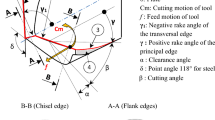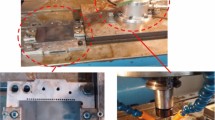Abstract
In this study, an electrical heat-assisted method was adopted to drill a small hole (diameter of 1–3 mm) in hard-to-cut materials, namely, 1Cr18Ni9Ti stainless steel and ZGMn13 high-manganese steel. The flank wear of the twist bit and the surface quality of the small hole were investigated. The relationships among the flank wear, feeding, heating current, and cutting speed were analyzed quantitatively. Flank wear of twist drill directly affected the service life of the drill used in electric hot drilling. The dynamic effects of heating current, cutting speed, and feed rate on the surface roughness and machining hardening of the hole-wall are also discussed. Experimental data indicated that the surface roughness after electric hot drilling can also be obtained by coarse grinding and the surface hardness of the hole-wall had no obvious change. These findings showed that electric hot drilling has irreplaceable advantages in improving the service life of the drill bit and surface quality of the hole-wall.
Similar content being viewed by others
References
Rahme P, Landon Y, Lachaud F, Piquet R (2015) Drilling of thick composite material with a small-diameter twist drill. Int J Adv Manuf Technol 76:1543–1553
Okada M, Asakawa N, Sentoku E, M’Saoubi R, Ueda T (2014) Cutting performance of an indexable insert drill for difficult-to-cut materials under supplied oil mist. Int J Adv Manuf Technol 72:475–485
DarYuan C, Lin SY (2012) Tool wear, hole characteristics, and manufacturing tolerance in alumina ceramic micro drilling process. Mater Manuf Process 27(3):306–313
Imran M, Mativenga PT, Kannan S (2012) Evaluation of the effects of tool geometry on tool wear and surface integrity in the micro drilling process for Inconel 718 alloy. Int J Mach Machin Mate 11(3):244–262
Chavoshi SZ, Behagh AM (2014) A note on influential control parameters for drilling of hard-to-machine steel by electrochemical discharge machining. Int J Adv Manuf Technol 71:1883–1887
Erol K, Mesut H (2010) Selection of optimum drilling parameters on burr height using response surface methodology and genetic algorithm in drilling of AISI 304 stainless steel. Mater Manuf Process 25(10):1068–1076
Tosun N (2006) Determination of optimum parameters for multiperformance characteristics in drilling by using grey relational analysis. Int J Adv Manuf Technol 26:450–455
Gopalsamy BM, Mondal B, Ghosh S (2009) Optimization of machining parameters for hard machining grey relational theory approach and ANOVA. Int J Adv Manuf Technol 45:1068–1086
Ulas Ç, Ahmet H, Omer B, Meyveci A (2011) Performance evaluation of different twist drills in dry drilling of AISI 304 austenitic stainless steel. Mater Manuf Process 26(8):951–960
George L, Liu T-I, Gao Z (2013) Online detection and measurements of drill wear for the drilling of stainless steel parts. Int J Adv Manuf Technol 68(5–8):1015–1022
Alighieri E, Yeo SH, Tan PC (2010) A new tool wear compensation method based on real-time estimation of material removal volume in micro-EDM. J Mater Process Technol 210(15):2292–2303
Ozler L, Dogru N (2013) An experimental investigation of hole geometry in friction drilling. Mater Manuf Process 28(4):470–475
Isbilir O, Ghassemieh E (2013) Comparative study of tool life and hole quality in drilling of CFRP/titanium stack using coated carbide drill. Mach Sci Technol 17(3):380–409
Jallageas J, K’nevez J-Y, Chérif M, Cahuc O (2013) Modeling and optimization of vibration-assisted drilling on positive feed drilling unit. Int J Adv Manuf Technol 67:1206–1216
Xu L, Wu Q, Bangyan Y (2012) Simulation and experiment of minipore drilling for austenitic stainless steel. J South Chin Univ Technol: Nat Sci Ed 39(1):95–98
Xu L, Wu Q, Hu X, B Ye (2010) Electrical properties analysis and control in electric hot drilling. 2010 The International Conference on Electrical and Control Engineering, Wuhan, China, June 26–28
Xu LY, Wu Q, Ye BY (2010) Heating current control in electric hot minipore drilling hard-to-cut material. Appl Mech Mat 34–35:1605–1608
Wu J (2010) Typical difficult-to-machine materials drilling technology related to basic research. Harbin Institute of Technology:11–15
Liu X, Xu W, Sun J (2012) Finite element simulation and experimental research on conductive heating and cutting. Chin Mech Eng 23(21):2556–2559
Silai X, Zhixiong Z, Zhenmei S (2011) Numerical simulation and experimental research on twist drill edge reinforcement design. Chin Mech Eng 22(14):1703–1707
Zhou Z (2000) A new type of drilling and grinding technology. Hunan University, Changsha, pp 56–58
Xu L, Wu Q, Hu X, Ye B (2013) Temperature simulation and experimental investigation of electric hot minipore drilling. J South Chin Univ Technol: Nat Sci Ed 39(1):95–98
Yu H (2009) Principles of metal plastic forming. Machinery Industry Press, Beijing, pp 113–116
Webster GA, Ezeilo AN (2001) Residual stress distribution and their influence on fatigue lifetimes. Int J Fatigue 23:375–383
Author information
Authors and Affiliations
Corresponding author
Rights and permissions
About this article
Cite this article
Xu, L., Wu, Q., Qin, M. et al. Flank wear of twist drills and surface quality of holes in hard-to-cut materials by electric hot drilling. Int J Adv Manuf Technol 84, 513–522 (2016). https://doi.org/10.1007/s00170-015-7721-y
Received:
Accepted:
Published:
Issue Date:
DOI: https://doi.org/10.1007/s00170-015-7721-y




